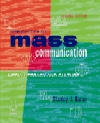Stanley J. Baran
| absolutist position | regarding the First Amendment, the idea that no law means no law
|
 |
 |
 |
| actual malice | the standard for libel in coverage of public figures consisting of knowledge of its falsity or reckless disregardî for whether it is true or not
|
 |
 |
 |
| ad hoc balancing of interests | in individual First Amendment cases, several factors should be weighed in determining how much freedom the press is granted
|
 |
 |
 |
| applied ethics | the application of metaethics and normative ethics to very specific situations
|
 |
 |
 |
| ascertainment | requires broadcasters to ascertain or actively and affirmatively determine the nature of their audiencesí interest, convenience, and necessity; no longer enforced
|
 |
 |
 |
| checkbook journalism | paying sources for information or interviewees for their interviews
|
 |
 |
 |
| confidentiality | the ability of media professionals to keep secret the names of people who provide them with information
|
 |
 |
 |
| copyright | identifying and granting ownership of a given piece of expression to protect the creators' financial interest in it
|
 |
 |
 |
| democracy | government by the people
|
 |
 |
 |
| editorial policy | newspapersí and magazinesí positions on certain specific issues
|
 |
 |
 |
| ethics | rules of behavior or moral principles that guide actions in given situations
|
 |
 |
 |
| Fairness Doctrine | requires broadcasters to cover issues of public importance and to be fair in that coverage; abolished in 1987
|
 |
 |
 |
| fair use | in copyright law, instances where material may be used without permission or payment
|
 |
 |
 |
| indecency | in broadcasting, language or material that depicts sexual or excretory activities in a way offensive to contemporary community standards
|
 |
 |
 |
| libel | the false and malicious publication of material that damages a personís reputatio (typically applied to print media)
|
 |
 |
 |
| libertarianism | philosophy of the press that asserts that good and rational people can tell right from wrong if presented with full and free access to information; therefore censorship is unnecessary
|
 |
 |
 |
| media councils | panels of people from both the media and the public who investigate complaints against the media and publish their findings
|
 |
 |
 |
| metaethics | examination of a cultureís understanding of its fundamental values
|
 |
 |
 |
| moral agent | in an ethical dilemma, the person making the decision
|
 |
 |
 |
| music licensing company | organizations that collect fees based on recorded music users' gross receipts and distribute the money to songwriters and artists
|
 |
 |
 |
| normative ethics | generalized theories, rules, and principles of ethical or moral behavior
|
 |
 |
 |
| normative theory | an idea that explains how media should ideally operate in a given system of social values
|
 |
 |
 |
| obscenity | unprotected expression determined by (a) whether the average person, applying contemporary community standards, would find that the work, taken as a whole, appeals to the prurient interest, (b) whether the work depicts or describes, in a patently offensive way, sexual conduct specifically defined by the applicable state law, and (c) whether the work, taken as a whole, lacks serious literary, artistic, political, or scientific value
|
 |
 |
 |
| ombudsman | internal arbiter of performance for media organizations
|
 |
 |
 |
| operating policy | spells out standards for everyday operations for newspapers and magazines
|
 |
 |
 |
| policy book | delineates standards of operation for local broadcasters
|
 |
 |
 |
| pornography | expression calculated solely to supply sexual excitement
|
 |
 |
 |
| prior restraint | power of the government to prevent the publication or broadcast of expression
|
 |
 |
 |
| public domain | in copyright law, the use of material without permission once the copyright expires
|
 |
 |
 |
| ride-alongs | the practice of allowing television reporters to accompany police in the conduct of their duty
|
 |
 |
 |
| safe harbor | times of the broadcast day (typically 10 p.m. to 6 a.m.) when children are not likely to be in the listening or viewing audience
|
 |
 |
 |
| self-righting principle | John Miltonís articulation of libertarianism
|
 |
 |
 |
| slander | oral or spoken defamation of a personís character (typically applied to broadcasting)
|
 |
 |
 |
| social responsibility theory (or model) | normative theory or model asserting that media must remain free of government control but, in exchange, must serve the public
|
 |
 |
 |
| Standards and Practices Department | the internal content review operation of a television network
|
 |
 |
 |
| traffic cop analogy | in broadcast regulation, the idea that the FCC, as a traffic cop, has the right to control not only the flow of broadcast traffic but its composition
|



 2002 McGraw-Hill Higher Education
2002 McGraw-Hill Higher Education